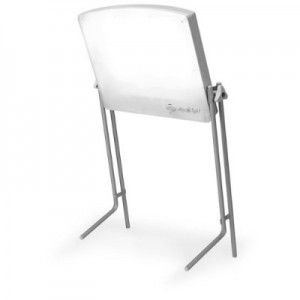The Light Box, Continued (Advent for the Skeptical and Weary, Part 3)
{…continued from The Light Box (Advent for the Skeptical and Weary, Part 2)}
The light arrived, and it looked like this:
I opened up the directions.
Oh, shut up, I thought.
The steps were simple:
1. Wake up early in the morning.
2. Set up the light on a tabletop and sit in front of it. Angle it so it hits your eyes from above, like sunlight.
3. Sit there for about half an hour. (“Feel free to read, eat breakfast, talk on the phone, etc.”, said the directions. Talk on the phone? What year were these directions written? Also, what depressed person has the wherewithal to call someone on the phone? And this phone conversation is supposed to happen at dawn?)
4. Do this every day throughout the winter.
I did this for a week. The hardest part was getting up at 6:00 am, when it was still coffin-dark, but that was the point. Once I was sitting there, it was not much different from any other breakfast. I read the news. I ate cereal. I like those two things. I was doing a pointless but not unpleasant task.
Except somewhere around the eighth day… the depression actually started to lift.
I clearly remember that lifting feeling because one day I found myself laughing a lot, and my own laughter startled me. The depression had come on so gradually that I never noticed exactly when I’d stopped laughing.
I tried to describe the effects to my mom and all I could say was “It’s the weirdest thing. It feels like springtime.”
This seemed like a near-miracle to me. This thing that had plagued me for years—I’d tricked it away with a light?
* * *
What shocks me most, looking back, is that I even bought that lamp. I truly didn’t think it was going to work.
I know I don’t look like the kind of person who often runs low on hope. I have one of those squishy round faces, and I smile a lot. Also, I don’t give up easily. There’s no bragging in that statement. I often persevere like an idiot when it would be wiser to set something aside.
Or I persevere on a good and necessary task, but with a silent sense of hopelessness. In labor with my first baby, pushing for more than an hour, the thought running through my mind was This is taking so long because I’m not strong enough. The contractions came on so fast and hard and close together, and as soon as I got into the hospital bed I retreated somewhere deep inside me to some pre-verbal animal brain where I could barely string words together, and I refused the epidural because I just couldn’t tolerate all the fussing and poking and interference. So I just kept on laboring and growling into my pillow and all the while thinking I’m not strong enough to do this.
It turned out the baby was OP (occiput posterior): facing the wrong way. It’s a hard way for a baby to make his way out of his mother’s body, and many OP babies end up born by c-section after long and excruciating labors. I’d birthed an eight-pound baby facing the wrong way with no epidural and no yelling. And everybody else knew that was something special, and all through the labor, my midwife and my mother and my husband kept saying you’re doing amazing, he’s coming, he’s coming, but I didn’t believe them. I couldn’t conceive of it ever ending. I was genuinely surprised when he finally arrived.
I couldn’t stop, but I had no anticipation of any joy at the end.
I didn’t believe all this labor was leading to anything. I didn’t believe he was coming.
If this is not a perfect descriptor of Advent for the Skeptical and Weary, I don’t know what is.
That’s one kind of hopelessness. Another is when you’re just too tired to hope anymore, or it’s painful to do so. When you’ve tried everything and gotten nothing. When you’ve done everything you can think of to find a job, find love, make a job work, make a relationship work, cure an illness, get pregnant, finally save some money and get out of debt, manifest a lifelong dream, get a business or creative project off the ground, get funding or get published or work for a cause or win an election or stop a war… It just hurts to hope anymore.
And if I intended this little reflection to be a sermon, I suppose it would end with all the reasons we should hope anyway, or put our hope in something higher. I would talk about how my baby came anyway and sometimes goodness is unstoppable and even our despair is powerless to stop it. And how despair is corrosive and destroys our childlike chance to wait with excitement and anticipation. But that’s not where I’m going with this.
I’m just taking this space to say: Sometimes it hurts to hope.
Sometimes you’re just too tired to hope.
And if that’s the case, what do you do at a time like Advent—a liturgical season about hope and expectant joy? Or if you’re nonreligious and Advent is irrelevant to you, anyway, except for the chocolate in the calendars, which is usually a depressing sort of chocolate, that waxy kind of chocolate formed into indiscernible blob shapes—OK, still the question remains: What is there to hope for? What are we to do?
This is what I think:
1. Go get better chocolate. Don’t settle for that waxy cardboard crap.
2. Just ask the question. Just put it out there and leave it open for a while. Don’t even admonish yourself to “love the questions,” as Rilke said. Ask it crankily, even, as I have been. Just leave it there like a file folder on your desk with nothing in it yet:
How do you celebrate hope, or practice hope, when you’re not sure what you’re hoping for?
Continued in Part 4: Little Doors.

